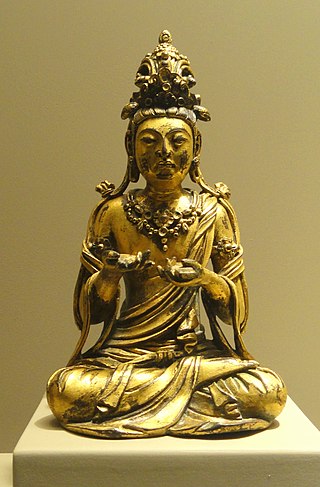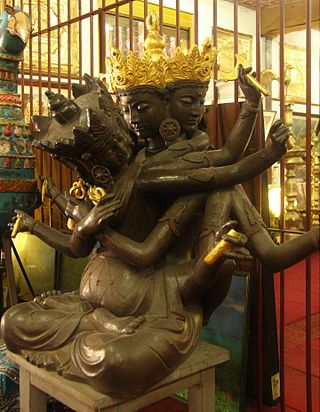Prajna or Prajñā may refer to:
- Prajñā (Hinduism), a Hindu concept
- Prajñā (Buddhism), a Buddhist concept
- Prajna (Buddhist monk), an important 9th century Buddhist monk from Gandhara
Prajna or Prajñā may refer to:

The Eightfold Path is an early summary of the path of Buddhist practices leading to liberation from samsara, the painful cycle of rebirth, in the form of nirvana.
Pāramitā or pāramī, is a Buddhist term often translated as "perfection". It is described in Buddhist commentaries as a noble character quality generally associated with enlightened beings. Pāramī and pāramitā are both terms in Pali but Pali literature makes greater reference to pāramī, while Mahayana texts generally use the Sanskrit pāramitā.

Kumārajīva was a Buddhist monk, scholar, missionary and translator from the Kingdom of Kucha. Kumārajīva is seen as one of the greatest translators of Chinese Buddhism. According to Lu Cheng, Kumarajiva's translations are "unparalleled either in terms of translation technique or degree of fidelity".

Jinul Puril Bojo Daesa, often called Jinul or Chinul for short, was a Korean monk of the Goryeo period, who is considered to be the most influential figure in the formation of Korean Seon (Zen) Buddhism. He is credited as the founder of the Jogye Order, by working to unify the disparate sects in Korean Buddhism into a cohesive organization.
Ximing Temple was a famous temple in Chang'an, the capital of the Tang dynasty in Chinese history. Chang'an, current day Xi'an, was the eastern terminus of the Silk Road, and a cosmopolitan metropolis. Ximing was established by Tang Gaozong in 656. It was at Ximing that pilgrim and traveller Xuanzang (602-664) had translated the scriptures he had brought back from India. Another traveller Yijing (635-713) also based himself at Ximing while working on translations of Indian scriptures. Indian scholar monk Shubhākarasimha, was responsible for the introduction of the Mahavairocana Sutra and the tantric traditions associated with it. Japanese monk, Kukai studied Sanskrit there under the tutelage of Gandharan pandit Prajñā (734-810?) who had been educated at the Indian Buddhist university at Nalanda. Ximing was celebrated for its library which was the most comprehensive library of Buddhist texts in China at the time. Woncheuk (613–696) was a Korean Buddhist monk, also known as Ximing Fashi (西明法师) after the name of this temple where he did most of his important work.

Subhūti was one of the ten principal disciples of the Buddha. In Theravada Buddhism he is considered the disciple who was foremost in being "worthy of gifts" and "living remote and in peace". In Mahayana Buddhism, he is considered foremost in understanding emptiness.

Vihāra generally refers to a Buddhist monastery for Buddhist renunciates, mostly in the Indian subcontinent. The concept is ancient and in early Sanskrit and Pali texts, it meant any arrangement of space or facilities for dwellings. The term evolved into an architectural concept wherein it refers to living quarters for monks with an open shared space or courtyard, particularly in Buddhism. The term is also found in Ajivika, Hindu and Jain monastic literature, usually referring to temporary refuge for wandering monks or nuns during the annual Indian monsoons. In modern Jainism, the monks continue to wander from town to town except during the rainy season (Chaturmas), and the term "vihara" refers to their wanderings.

Prajñā or paññā, is a Buddhist term often translated as "wisdom", "intelligence", or "understanding". It is described in Buddhist texts as the understanding of the true nature of phenomena. In the context of Buddhist meditation, it is the ability to understand the three characteristics of all things: anicca ("impermanence"), dukkha, and anattā ("non-self"). Mahāyāna texts describe it as the understanding of śūnyatā ("emptiness"). It is part of the Threefold Training in Buddhism, and is one of the ten pāramīs of Theravāda Buddhism and one of the six Mahāyāna pāramitās.
Prajñā, was a 9th-century Buddhist monk born in Kapisa, near modern Kabul, Afghanistan.

Yab-yum is a common symbol in the Tibetan Buddhist art of India, Bhutan, Nepal, and Tibet. It represents the primordial union of wisdom and compassion, depicted as a male deity in union with his female consort through the similar ideas of interpenetration or "coalescence", using the concept of Indra's net to illustrate this. The male figure represents compassion and skillful means, while the female partner represents insight. In yab-yum the female is seated on the male's lap. There is a rare presentation of a similar figure but reversed, with the male sitting on the female's lap, called yum-yab.

Lushan Huiyuan, meaning "Huiyuan of Mount Lu", was a Chinese Buddhist teacher who founded Donglin Temple at the foot of Mountain Lu in Jiujiang province and wrote the text On Why Monks Do Not Bow Down Before Kings in 404 AD. He was born in Shanxi province but moved to Jiujiang, where he died in 416. Although he was born in the north, he moved south to live within the bounds of the Eastern Jin Dynasty.
A sayadaw is a Burmese Buddhist title used to reference the senior monk or abbot of a monastery. Some distinguished sayadaws would often be referred to as a sayadawgyi (ဆရာတော်ကြီး, as a sign of reverence. The terms "sayadaw" and "sayadawgyi" originally corresponded to the senior monks who taught the former Burmese kings. These sayadaws may be influential teachers of Buddhism and also important meditation practitioners. They usually are abbots of monasteries or monastery networks with many resident monks and a lay following.
Kasaya may refer to:
Spiritual friendship may refer to:

Huiguo (746–805) was a Buddhist monk of Tang China who studied and taught Chinese Esoteric Buddhism, a Vajrayana tradition recently imported from India. Later Huiguo would become the teacher of Kūkai, founder of Shingon Buddhism, a prominent school of Buddhism in Japan.
The Shaolin School is a fictional martial arts school mentioned in several works of wuxia fiction. It is one of the largest and best-known orthodox schools in the wulin. Its base is in Shaolin Monastery, Henan, China. It is also sometimes referred to as "Shaolin Monastery" or "Shaolin Temple" instead of "Shaolin School".
Samatha, "calm," "serenity," "tranquillity of awareness," and vipassanā, literally "special, super, seeing ", are two qualities of the mind developed in tandem in Buddhist practice.
Geyi originated as a 3rd-century Chinese Buddhist method for explaining lists of Sanskrit terms from the Buddhist canon with comparable lists from Chinese classics; but many 20th-century scholars of Buddhism misconstrued geyi "matching concepts" as a supposed method of translating Sanskrit technical terminology with Chinese Daoist vocabulary. This reputed geyi "matching concepts" or "matching meanings" definition is ubiquitous in modern reference works, including academic articles, textbooks on Buddhism, dictionaries, encyclopedias, and Web-based resources.
Mahinda may refer to:
Maka hannya haramitsu, the Japanese transliteration of Mahāprajñāpāramitā meaning The Perfection of Great Wisdom, is the second book of the Shōbōgenzō by the 13th century Sōtō Zen monk Eihei Dōgen. It is the second book in not only the original 60 and 75 fascicle versions of the text, but also the later 95 fascicle compilations. It was written in Kyoto in the summer of 1233, the first year that Dōgen began occupying the temple that what would soon become Kōshōhōrin-ji. As the title suggests, this chapter lays out Dōgen's interpretation of the Mahaprajñāpāramitāhṛdaya Sūtra, or Heart Sutra, so called because it is supposed to represent the heart of the 600 volumes of the Mahāprajñāpāramitā Sūtra. The Heart Sutra focuses on the Buddhist concept of prajñā, or wisdom, which indicates not conventional wisdom, but rather wisdom regarding the emptiness of all phenomena. As Dōgen argues in this chapter, prajñā is identical to the practice of zazen, not a way of thinking.